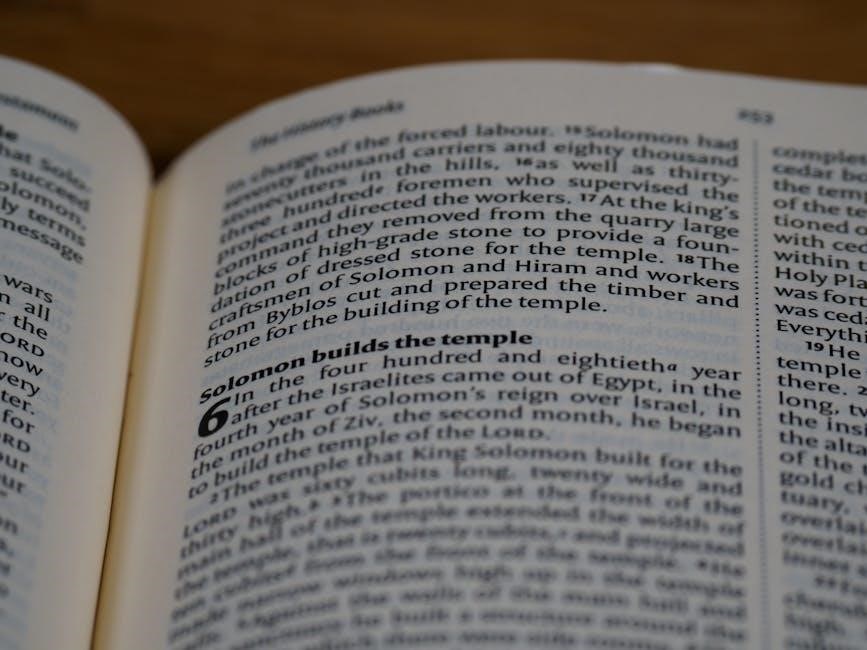Overview of the Key of Solomon
The Key of Solomon‚ or Clavicula Salomonis‚ is a famous grimoire attributed to King Solomon. It’s a pseudepigraphical text from the 14th-15th century Italian Renaissance. The “Greater Key” details magical practices and rituals. It exists in various editions and translations.
Definition and Alternate Names
The Key of Solomon‚ a prominent grimoire‚ is also known as Clavicula Salomonis in Latin. In Hebrew‚ it’s referred to as Map̄teḥ Šəlomo. This pseudepigraphical work is attributed to King Solomon‚ though its origins likely trace back to the Italian Renaissance‚ specifically the 14th or 15th century. Often called the “Greater Key of Solomon” to distinguish it from the “Lesser Key‚” or Lemegeton‚ it serves as a foundational text in Western occultism. It presents a structured approach to magical practices‚ detailing rituals for summoning and commanding spirits. Various editions and translations exist‚ making it accessible to scholars and practitioners alike. These editions often differ in content and interpretation‚ reflecting the complex transmission history of the grimoire.
The Key of Solomon emerged during the Renaissance‚ despite its attribution to King Solomon; Its origins are traced to the 14th or 15th century‚ reflecting the era’s fascination with magic and ancient wisdom.
Origins and Dating
The precise origins of the Key of Solomon remain debated‚ with scholarly consensus placing its composition during the European Renaissance‚ specifically the 14th or 15th century. Despite being attributed to King Solomon‚ the text’s language‚ magical systems‚ and historical references point to a later period. This era witnessed a resurgence of interest in Hermeticism‚ Jewish Kabbalah‚ and Graeco-Roman magic‚ all of which influenced the grimoire’s content. Various manuscripts exist‚ showcasing the evolution of the text over time. Determining a single “original” version is challenging‚ as different copies offer variations in rituals‚ spells‚ and illustrations. The Italian Renaissance is considered the most probable period for its genesis.
Historical Context
Attribution to King Solomon
The attribution of the Key of Solomon to King Solomon serves a crucial purpose: lending authority and prestige to the grimoire’s contents. Solomon‚ revered in Jewish‚ Christian‚ and Islamic traditions for his wisdom and magical prowess‚ represents the archetype of the wise king who possessed divine knowledge. By claiming Solomonic authorship‚ the text seeks to legitimize its magical practices and elevate its status among practitioners. This pseudepigraphical attribution was a common practice in antiquity and the Renaissance‚ where associating texts with revered figures enhanced their credibility. While historical evidence does not support Solomon’s direct involvement‚ the association reinforces the grimoire’s claim to ancient wisdom and magical efficacy‚ making it appealing to those seeking esoteric knowledge.
The Key of Solomon follows a grimoire format‚ serving as a handbook for magic. It details rituals‚ spells‚ and instructions for summoning spirits. Its purpose is to provide practitioners with the means to achieve specific goals.
Grimoire Format and Purpose
The Key of Solomon‚ a quintessential grimoire‚ functions as a comprehensive manual for ceremonial magic. Its format typically includes detailed instructions for performing rituals‚ crafting talismans‚ and invoking spirits. The grimoire aims to empower the magician with the knowledge and tools necessary to influence events and command supernatural entities. It outlines specific procedures‚ including prayers‚ incantations‚ and preparations‚ believed to facilitate communication with and control over spirits. The purpose of the Key of Solomon is to provide a framework for practitioners to achieve desired outcomes through occult means‚ offering a structured approach to harnessing magical power.

Content and Structure
Key Subject Matter and Themes
The Key of Solomon explores a range of subjects central to ceremonial magic. A primary theme is the evocation and control of spirits‚ with detailed instructions for summoning and commanding various entities. The text also delves into the creation and consecration of talismans and pentacles‚ believed to possess magical properties. Astrology plays a significant role‚ influencing the timing and execution of rituals. Divine names and angelic hierarchies are invoked to lend power to magical operations. Ultimately‚ the Key of Solomon seeks to provide a framework for attaining wisdom‚ power‚ and control over the natural and supernatural realms through occult means.
S. Liddell MacGregor Mathers produced a notable English edition in 1888. This version has become widely influential in Western occultism. It offers a structured presentation of the grimoire’s contents. Mathers’ work helped popularize The Key of Solomon.
S. Liddell MacGregor Mathers Edition
S. Liddell MacGregor Mathers’ 1888 edition of The Key of Solomon is a cornerstone for English-speaking occultists. He translated and compiled manuscripts from the British Museum. Mathers’ work brought structure and accessibility to the grimoire’s complex content. His edition is celebrated for its clarity. It has greatly impacted modern ceremonial magic. Some portions are excised from the Goetic sections. This version remains a seminal text. It is used by students and practitioners. It’s readily available in PDF format and in print. Mathers’ translation includes detailed illustrations and explanations. These elements aid in understanding the rituals. His edition is fundamental to studying Qabalistical and Ceremonial Magic. It is an essential resource for those interested in this grimoire.

Editions and Translations
Availability in PDF Format
The Key of Solomon is widely accessible in PDF format‚ ensuring its broad distribution. Digital versions offer convenience and ease of access for researchers and practitioners. Many websites provide free PDF downloads‚ though the quality and accuracy of these versions may vary. Scanned manuscripts and transcribed editions are both found online. Some PDFs include illustrations‚ while others focus solely on the text. The S. Liddell MacGregor Mathers edition is a commonly available PDF. Users should exercise caution when downloading from unknown sources to avoid corrupted files. The availability of The Key of Solomon in PDF format has democratized access to this important grimoire. It allows for study and exploration by a global audience. This contributes to its enduring influence.
The Lesser Key of Solomon (Lemegeton)
The Lesser Key of Solomon‚ also known as Lemegeton‚ is a related grimoire. It details summoning and commanding spirits. It complements the Greater Key. Both texts are attributed to King Solomon.
The Lesser Key of Solomon (Lemegeton)
The Lesser Key of Solomon‚ or Lemegeton Clavicula Salomonis Regis‚ is another grimoire associated with Solomon. Unlike the Greater Key‚ it focuses on demonology. It provides instructions for summoning and commanding spirits. The Lemegeton is divided into five books‚ including the Ars Goetia. The Ars Goetia specifically details the evocation of seventy-two demons. This section is often extracted and studied separately. Editions of the Greater Key sometimes excise Goetic portions. The Lemegeton offers practical magic for controlling spirits. It complements the theoretical framework of the Key of Solomon. Together‚ the two keys offer a comprehensive system of magic.

Related Texts
Relationship to Other Grimoires
The Key of Solomon holds a prominent position amongst numerous other grimoires. These grimoires explore magic‚ demonology‚ and occult practices. Texts like the Grand Grimoire also delve into summoning spirits. Many grimoires share similar themes‚ rituals‚ and hierarchies. The Key of Solomon stands out due to its detailed instructions. It also includes its purported Solomonic origins. Some grimoires borrow from the Key of Solomon‚ adapting or expanding its teachings. Others offer alternative systems. The Heptameron‚ for example‚ presents a simplified ritual magic system. Exploring the relationships between these texts reveals interconnectedness. It helps us understand the evolution of Western occultism. Understanding these grimoires highlights the rich tapestry of magical traditions.

Influence and Legacy
The Key of Solomon significantly impacted Western occultism‚ influencing magical practices and ceremonial traditions. Its rituals and symbolism appear in various modern esoteric systems‚ and its legacy persists in contemporary occult studies.
Impact on Western Occultism
The Key of Solomon stands as a foundational text‚ deeply influencing the course of Western occultism. Its detailed instructions for rituals‚ summoning spirits‚ and utilizing magical tools have shaped the practices of ceremonial magic and Qabalistic traditions. The grimoire’s emphasis on correspondences‚ planetary influences‚ and the power of names has been adopted and adapted by numerous occultists throughout history. Its influence extends to modern Wicca and Neopaganism‚ where its concepts and symbolism continue to inspire practitioners. The Key of Solomon’s enduring legacy solidifies its position as a cornerstone of Western esoteric thought‚ shaping magical theory and practice for centuries. The text’s availability in PDF format ensures its continued accessibility for modern scholars and practitioners.
Influence and Legacy
References in Popular Culture
The Key of Solomon‚ with its rich symbolism and magical themes‚ has permeated popular culture in diverse ways. Its imagery and concepts frequently appear in literature‚ film‚ and video games‚ often associated with secret societies‚ powerful artifacts‚ and mystical quests. Characters might consult the Key of Solomon to summon entities or decipher ancient prophecies. The grimoire’s sigils and pentacles are often incorporated into visual representations of magic and the occult; The book’s reputation as a source of forbidden knowledge makes it a compelling element in narratives exploring power‚ corruption‚ and the hidden realms of reality. Even the existence of downloadable PDF versions contributes to its accessibility‚ fueling further imaginative interpretations in contemporary media. Its influence remains subtly embedded within popular narratives.

